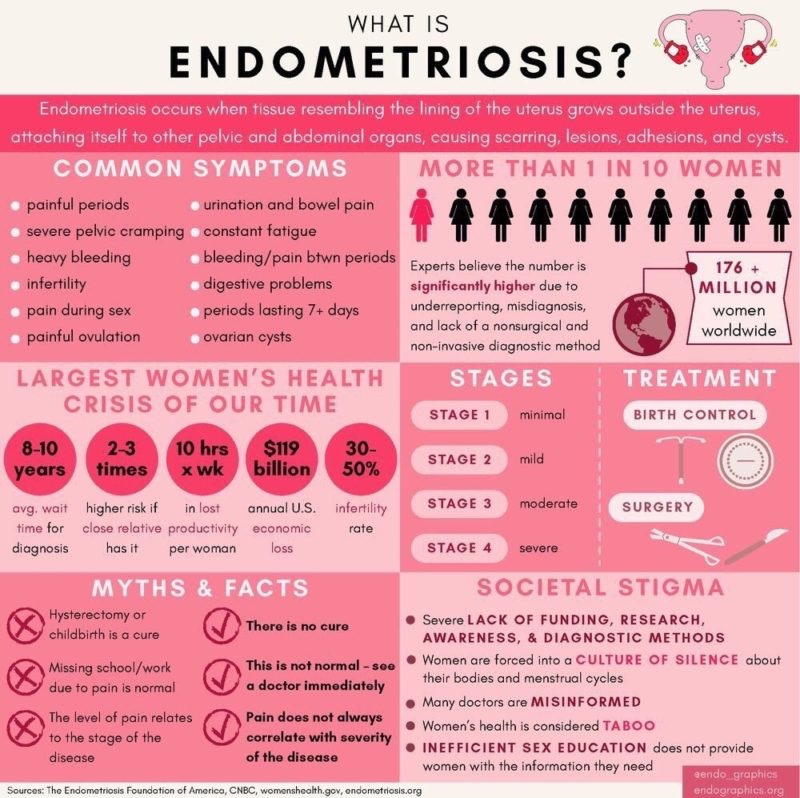Endometriosis can affect day-to-day life, but there are treatments to help
The month of March is Endometriosis Awareness Month, and with endometriosis affecting roughly 10% (190 million) of reproductive age women and girls globally, according to the World Health Organization (WHO), it’s a prevalent health concern for many women.
The Mayo Clinic describes endometriosis as an often painful disorder in which tissue similar to the tissue that normally lines the inside of your uterus — the endometrium — grows outside your uterus.
“Endometriosis most commonly involves your ovaries, fallopian tubes and the tissue lining your pelvis. Rarely, endometrial-like tissue may be found beyond the area where pelvic organs are located,” explains The Mayo Clinic.
Symptoms can create life-impacting pain

As explained by WHO, endometriosis sufferers can have severe, life-impacting pain during periods, sexual intercourse, bowel movements and/or urination.
Symptoms are wide-ranging and can be unique to each individual, however, they include:
- painful periods
- chronic pelvic pain
- pain during and/or after sexual intercourse
- painful bowel movements
- painful urination
- fatigue
- depression or anxiety
- abdominal bloating and nausea
Emma Cox, CEO of charity Endometriosis UK, spoke to the BBC, stating, "It cannot be overstated the devastating impact this condition is clearly having on people's physical and mental health. "Without investment in research, a reduction in diagnosis time - which averages at a shocking 7.5 years - and better access to pain management, women will continue to face huge barriers in accessing the right treatment at the right time."
Endometriosis causes
So what causes the condition? While the exact cause hasn’t been defined, the Mayo Clinic lists some possible explanations, which include retrograde menstruation, surgical scar implantation, and immune system disorder.
However, while endometriosis undeniably affects women in their day-to-day life, there are thankfully treatments that can provide some relief.
Pain medications, hormone therapy, hormonal contraceptives, conservative surgery and last-resort surgery (hysterectomy) are just some treatment options listed by Healthline, which highlights that everyone reacts differently to each option and doctors will first try conservative treatments before moving on to surgery.
Endometriosis UK spoke to a wide range of sufferers, with Tanya Marshall, 24, expressing concern over treatments.
“I worry every day about my opioid intake. I take 50ml of morphine sulfate, Fentanyl patches, Naproxen and 30mg of amitriptyline and although I'm not addicted in my mind, my body is physically dependent on this now. If I went a day without it, I would start to experience nasty withdrawal symptoms,” she said.
With diagnosis comes hope
Bethany Willis, 19, initially wanted to end her life due to the pain, stating, “The pain is like barbed wire wrapped around your insides and someone's pulling it while at the same time an animal is trying to eat its way through you."I texted my boyfriend and said goodbye. I was ready to end my life there and then because of the pain."
However, with diagnosis comes hope. After surgery, Bethany has managed to cope. “My mind is clearer and I have more energy, but the years of not being treated mean I've had to drop out of veterinary school and my dream career," she explains.
If you are experiencing endometriosis, don't suffer in silence. Reach out to your health professional as soon as possible, who will be able to help manage the disease and lessen the impact on your day-to-day life.